Unlock the Secrets of Footfall: Boost Your Business with Proven Insights
Footfall, also called People Counting and Traffic Counting, is a crucial metric for businesses and organizations with brick-and-mortar store locations. It measures the number of people entering a shop or shopping mall and provides valuable insights into customer behavior, preferences, and movement patterns. However, many marketers fail to utilize footfall data effectively in their digital marketing strategy. This is where our expertise comes in. We aim to provide you with all aspects of Footfall and unlock your store's potential visit traffic. By optimizing your location marketing in your digital strategy, you can gain a competitive advantage and drive growth and profitability in today's challenging retail environment. So, let us explore the world of footfall together!
What does footfall mean in marketing?
Footfall, also known as People Counting, Shopper Counting, or Traffic Counting, measures the number of people entering a shop or shopping mall. This key metric can provide valuable insights into other important factors essential for survival in today's retail industry, such as conversion rates and average transaction value (ATV).
Calculating footfall is critical for store and senior managers looking to increase sales and drive profits. By accurately counting footfall, retailers can identify the number of in-store purchasing opportunities at any given time of day. This information is particularly important when combined with sales data, as it can help retailers to understand how many sales opportunities they are missing out on.
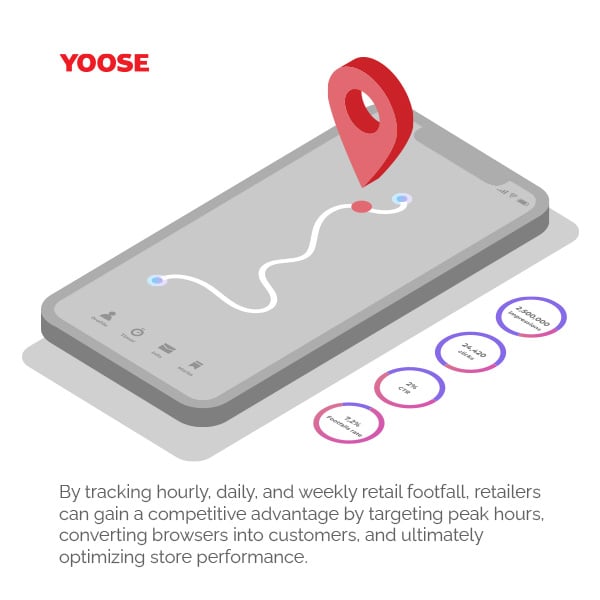
By tracking hourly, daily, and weekly retail footfall, retailers can gain a competitive advantage by targeting peak hours, converting browsers into customers, and optimizing store performance. Access to this data can help retailers make informed decisions that drive growth and profitability in today's challenging retail environment.
Why is footfall important?
Footfall is important for a variety of reasons, as it serves as an indicator of the performance and popularity of a business or location. Here are some more detailed explanations for the importance of footfall:
- Assessing customer traffic: Footfall measures the number of potential customers visiting a location, helping businesses understand their customer base and interest in their products or services.
- Evaluating marketing efforts: By tracking footfall before, during, and after marketing campaigns, businesses can gauge the effectiveness of their promotional efforts and determine which strategies are most successful in attracting customers.
- Identifying trends and patterns: Regularly monitoring footfall can reveal trends and patterns in customer behavior, such as peak times, seasonal fluctuations, or the impact of external events. This information can be used to make informed decisions about staffing, inventory management, and operational hours.
- Optimizing store layout: Footfall data can help businesses understand which areas of a store are most frequently by customers, enabling them to optimize product placement, store layout, and signage to improve customer experience and encourage sales.
- Enhancing customer experience: Analyzing footfall data with other performance metrics, such as conversion rates and customer satisfaction, can provide valuable insights into the overall customer experience. This information can be used to identify areas for improvement and implement changes to better meet customer needs and expectations.
- Resource allocation and staffing: Footfall data can help businesses determine the appropriate staffing levels to maintain excellent customer service and manage resources effectively. By understanding when customer traffic is highest, businesses can ensure adequate staff to assist customers and manage operations.
- Benchmarking performance: Comparing footfall data to industry averages or competitors can provide businesses with a benchmark for their performance, enabling them to identify areas where they excel or require improvement.
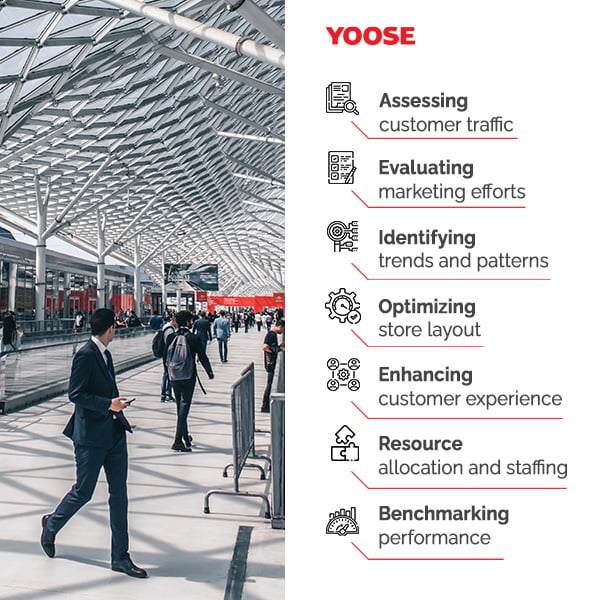
Overall, footfall is a crucial metric for businesses and organizations. It helps them measure their performance, make data-driven decisions, and adapt their strategies to serve their customers better and achieve their goals.
How to calculate footfall?
Footfall attribution is a crucial method that enables brick-and-mortar businesses to measure the impact of their digital marketing campaigns on store visits. This technique provides valuable insights to these businesses that base their success on the number of customers walking into their physical stores.
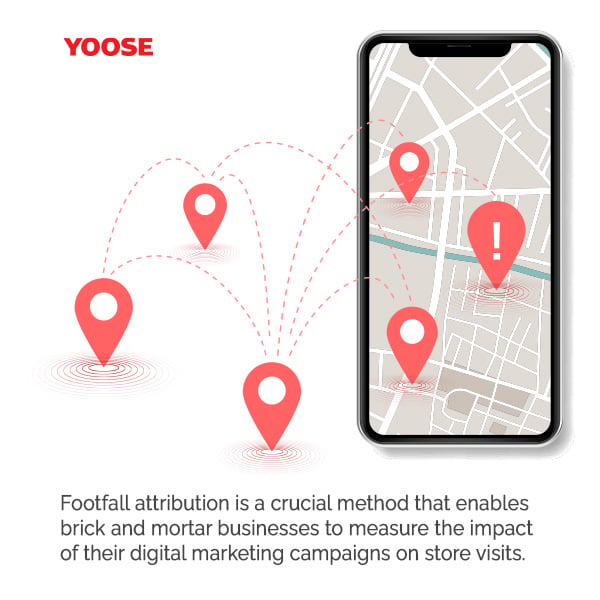
The process of footfall attribution involves several key steps. Firstly, a tracking pixel is fired when an ad is served, and the advertising ID is matched to a Customer Data Platform (CDP). Then, during and after the campaign, selected locations are monitored for store visits. The ID is automatically detected when the device owner enters a store, and the footfall is tracked. Finally, real-time offline attribution reports and footfall data streams are made available to provide detailed insights into the marketing campaign's success.
Overall, footfall attribution is an effective tool for businesses to determine the impact of their digital marketing campaigns on physical store visits. By implementing this technique, businesses can better understand their customers' behavior and tailor their marketing efforts accordingly.
Other methods to calculate
- Manual counting: Assign staff members or volunteers to count the number of people entering and exiting the area during the chosen period. They can use a clicker or make tally marks on a sheet of paper to keep track.
- Video cameras: Install video cameras to record foot traffic and then review the footage later to count the number of people. This method can be time-consuming but provides a visual record of footfall.
- Electronic sensors: Install sensors such as infrared beams or pressure-sensitive mats at your chosen area's entrance and exit points. These sensors can automatically count the number of people passing through and provide real-time data.
- Gather and analyze the data: Regardless of the method, collect the footfall data during the specified period. For manual counting and video camera methods, make sure to count and record the data accurately. For electronic sensors, extract the data from the devices or software.
Calculate footfall: Add up the total number of people entering the area during the chosen period. If you're measuring footfall over several days or weeks, calculate the average daily footfall by dividing the total number of people by the number of days.
How can footfall data be used to improve customer experience?
Footfall data can significantly enhance customer experience by providing insights into customer behavior, preferences, and movement patterns. Here's a more in-depth look at how footfall data can be used to improve the customer experience:
- Identifying high-traffic areas: Businesses can determine which areas attract the most visitors by analyzing footfall data. This information can be used to optimize product placement, ensuring that popular products are easily accessible and prominently displayed.
- Optimizing store layout and design: Footfall data can reveal customer movement patterns, which can be used to create more efficient and enjoyable store layouts. For example, businesses can arrange aisles and displays to minimize congestion and encourage customers to explore more sections of the store.
- Personalizing marketing efforts: By understanding footfall patterns, businesses can tailor marketing efforts to target specific customer segments based on their behavior and preferences. This may include offering personalized promotions, tailoring in-store advertising, or using targeted messaging on digital platforms.
- Adjusting staffing levels: Footfall data can help businesses determine when they need more staff to assist customers, ensuring that customer service remains consistent and high-quality during peak times. This can lead to shorter wait times, better service, and increased customer satisfaction.
- Enhancing in-store experiences: Analyzing footfall data can help businesses identify opportunities to create unique and engaging in-store experiences that drive customer loyalty and repeat visits. This could include hosting special events, offering product demonstrations, or creating interactive displays.
- Reducing customer frustration: By understanding customer flow and identifying bottlenecks or areas of congestion within a store, businesses can implement changes to reduce customer frustration, such as improving store layout, adding more checkout lanes, or providing additional seating areas.
- Testing and refining strategies: Footfall data can be used to measure the impact of changes made to store layouts, marketing efforts, or customer service strategies. By continually monitoring and analyzing footfall data, businesses can refine their strategies and make data-driven decisions to improve the overall customer experience.
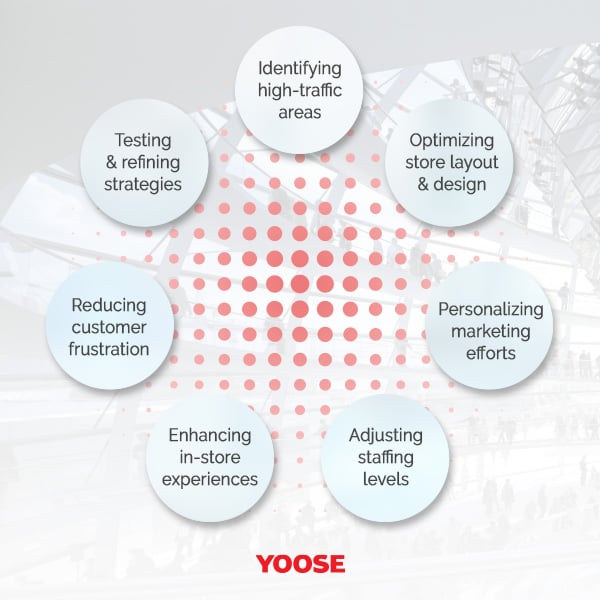
In summary, footfall data provides valuable insights into customer behavior and preferences, allowing businesses to make informed decisions to enhance customer experience. Businesses can create an environment that meets customer needs and drives customer satisfaction by optimizing store layouts, tailoring marketing efforts, adjusting staffing levels, and continually refining strategies. Real case study of the footfall.
How can footfall data be used to optimize store layouts?
Optimizing store layouts is essential for improving customer experience, increasing sales, and maximizing the efficiency of retail space. Footfall data can provide valuable insights into customer movement patterns and preferences, which can be used to make data-driven store layouts and design decisions. Here's a more in-depth look at how footfall data can be used to optimize store layouts:
- Identifying high-traffic areas: Analyzing footfall data can reveal the areas within a store that attract the most customer traffic. By placing popular or high-margin products in these high-traffic areas, businesses can capitalize on increased visibility and potentially boost sales.
- Enhancing customer flow: Footfall data can help businesses understand how customers move through their store, allowing them to design layouts that facilitate smooth movement and minimize congestion. This may involve strategically placing aisles, displays, and fixtures to create a more enjoyable and efficient shopping experience.
- Encouraging product discovery: By studying footfall data, businesses can identify store areas that are frequently overlooked or underutilized. By repositioning products, adding eye-catching signage, or creating engaging displays in these areas, businesses can encourage customers to explore more of the store and discover new products.
- Strategically placing promotional items: Footfall data can inform the placement of promotional items and sale displays to maximize their effectiveness. By positioning these items in high-traffic areas or along frequently traveled paths, businesses can increase the likelihood that customers will notice and take advantage of promotional offers.
- Balancing space utilization: Analyzing footfall data can help businesses understand which areas of their store are overcrowded or underutilized. This information can be used to redistribute merchandise, displays, or fixtures to create a more balanced and efficient use of space.
- Optimizing checkout areas: Footfall data can be used to identify the best locations for checkout areas based on customer traffic patterns. By placing checkout areas in convenient locations that minimize customer wait times and ensure a smooth flow of traffic, businesses can improve customer satisfaction and reduce the likelihood of abandoned purchases.
- Evaluating layout changes: Footfall data can be used to measure the impact of changes made to store layouts. By comparing footfall data before and after layout adjustments, businesses can determine whether their changes have had the desired effect on customer behavior and make further refinements as needed.
In brief, footfall data can provide valuable insights into customer behavior and preferences that can be used to optimize store layouts. By strategically positioning products, improving customer flow, and continually refining store design based on footfall data, businesses can create an environment that encourages sales, maximizes space utilization, and enhances the overall shopping experience.
How can I increase footfall in my store?
Increasing footfall in a store is essential for driving sales, improving customer engagement, and ensuring the success of a retail business. Here's a more in-depth look at various strategies to increase footfall in a store:
Enhance store visibility: Make sure your store is easily visible and accessible to potential customers. This includes clear, attractive signage, well-lit exteriors, and clean, welcoming storefronts. Consider placing promotional materials or displays in high-traffic areas in malls or shopping centers to draw attention to your store.
Offer promotions and discounts: Sales promotions, discounts, and special offers can attract customers to your store. Promote these deals through advertising, social media, and in-store signage to maximize their reach and impact.
Improve customer experience: Focus on providing excellent customer service, maintaining a clean and organized store, and creating a pleasant shopping atmosphere. A positive customer experience can encourage repeat visits and word-of-mouth referrals.
Host events and workshops: Organize in-store events, workshops, or product demonstrations to draw customers to your store. These events can generate interest, showcase your products, and give customers a unique and engaging experience.
Engage in targeted marketing: Use traditional and digital marketing channels to reach your target audience effectively. Develop advertising campaigns, create engaging content for social media, and consider using targeted online advertising to reach potential customers.
Maintain a strong online presence: In today's digital age, having a strong online presence is crucial for attracting customers. Maintain an updated and user-friendly website, engage with customers on social media, and ensure your store is listed on popular online directories and review sites.
Collaborate with local businesses: Partner with local businesses to cross-promote each other and host joint events or promotions. This can help you reach new customers and create a sense of community.
Adapt to changing consumer preferences: Keep up-to-date with the latest trends and consumer preferences to ensure your products and services remain relevant and appealing. Regularly update your product offerings, store layout, and marketing strategies to stay competitive.
Offer loyalty programs: Implement loyalty programs to reward repeat customers and incentivize them to continue shopping at your store. This can help build a loyal customer base and encourage more frequent visits.
Monitor and analyze footfall data: Regularly collect and analyze footfall data to identify trends, patterns, and areas for improvement. Use this data to make informed decisions about store layout, marketing efforts, and other strategies to increase footfall.
By combining these strategies and continually monitoring footfall data, you can increase footfall in your store, ultimately leading to increased sales, customer engagement, and overall success.
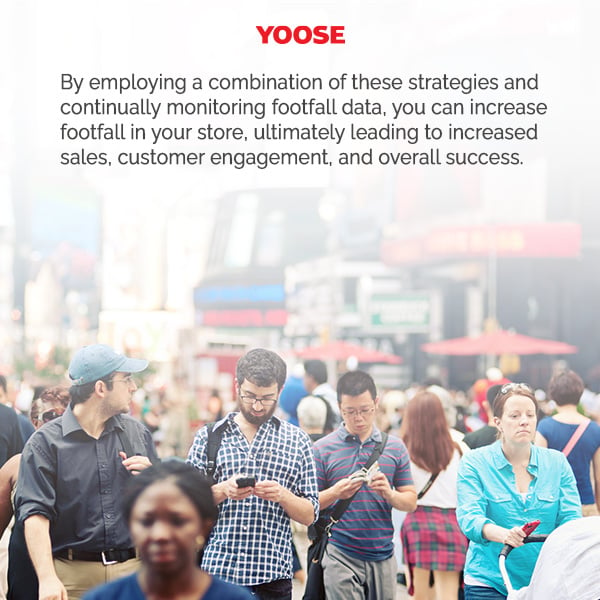
The future trends in footfall measurement
The increasing use of people counting technology: People counting technology is becoming increasingly affordable and sophisticated, making it a more viable option for businesses of all sizes. This technology can track footfall in real-time, providing businesses valuable insights into customer behavior.
The development of more accurate footfall data: Footfall data is becoming more accurate as businesses adopt new technologies and methods for collecting data. For example, some businesses are now using artificial intelligence to analyze footfall data and identify trends that would be difficult to spot with traditional methods.
The growing importance of privacy concerns: As businesses collect more and more customer data, privacy concerns are becoming more important. Businesses need to be transparent about how they collect and use footfall data and take steps to protect customer privacy.
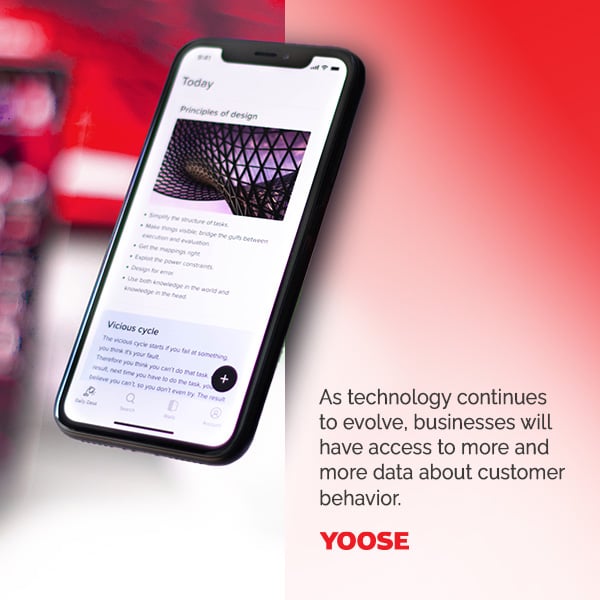
These are just a few of the future trends in footfall measurement. As technology evolves, businesses will have access to more and more data about customer behavior. This data can improve marketing campaigns, make better decisions about store layout and promotions, and improve customer service.
The real case study of footfall
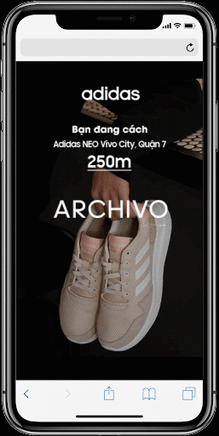 YOOSE, a leading location-based marketing agency, successfully collaborated with Adidas in a case study to increase footfall and drive customers to their retail stores.
YOOSE, a leading location-based marketing agency, successfully collaborated with Adidas in a case study to increase footfall and drive customers to their retail stores.
Adidas Vietnam sought to enhance brand awareness during the launch of new products by directing traffic to its 17 retail locations nationwide. To achieve this objective, YOOSE employed a strategic solution targeting a younger demographic while implementing a 200-meter geofence around each store. Additionally, YOOSE utilized dynamic banners that displayed real-time distances to the nearest Adidas store, capturing customer attention and encouraging interaction.
The campaign produced outstanding results, with 2,009,762 impressions, 24,519 clicks, and a 6.99% footfall rate, demonstrating the effectiveness of YOOSE's location-based marketing strategies in driving store visits and increasing overall engagement.
More details here: https://www.yoose.com/case-study-adidas
Want to know more about footfall?
YOOSE offers a solution to overcome the challenges of scalability and precise localization. YOOSE is the leading expert in location-based marketing solutions. We can provide to manage, map, visualize, and interact with billions of data points in real-time on interactive geo charts. If you want to learn more about how location-based marketing can help you connect with customers at every stage of the customer lifecycle, contact YOOSE today for a discussion.



